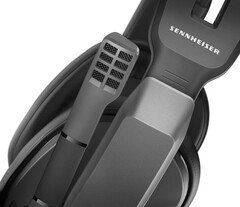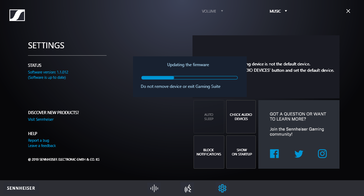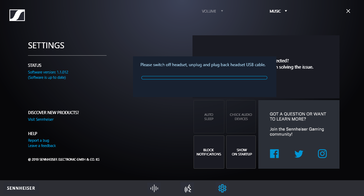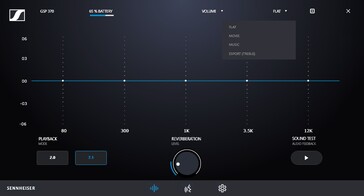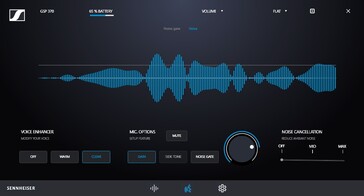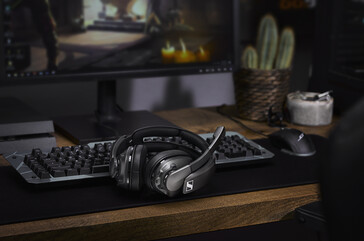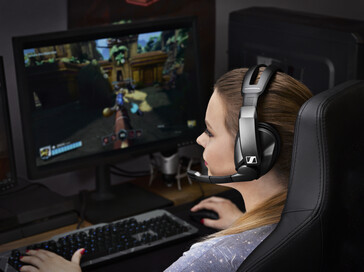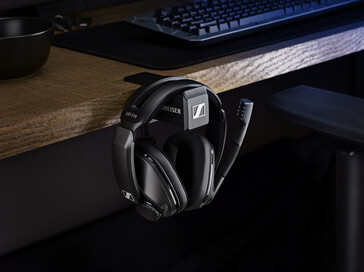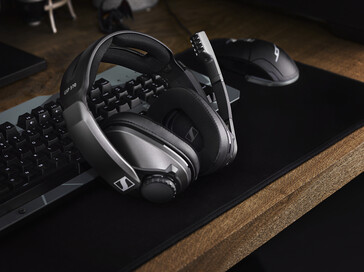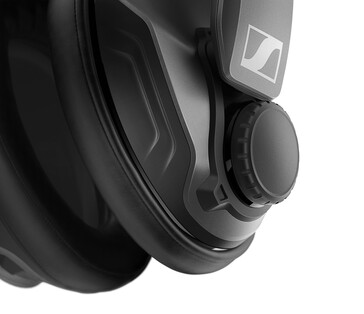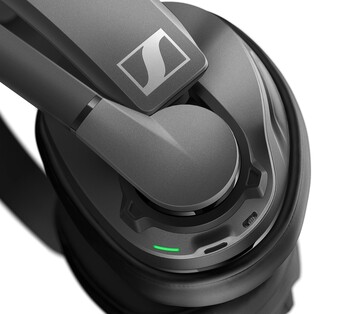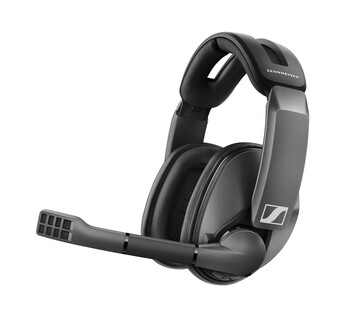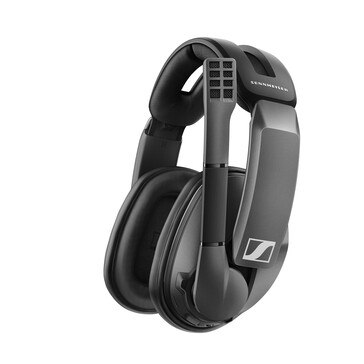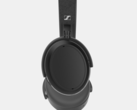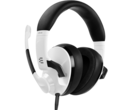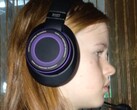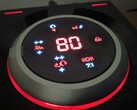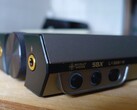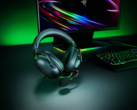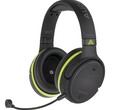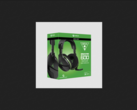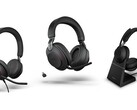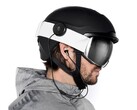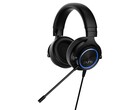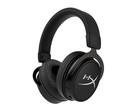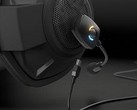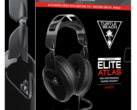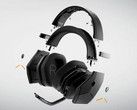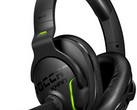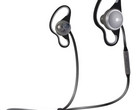Until earlier today, the only choice for the Sennheiser fans looking for a wireless headset was the rather expensive GSP 670 headset that came with excellent acoustics, state-of-the-art low latency connectivity, but only 16 to 20 hours of battery life and a price tag of US$349.5. The new GSP 370 is the second wireless headset of the popular German audio company and comes with much better autonomy and almost half the price. Obviously, some sacrifices had to be made to achieve both goals, so today we should try to answer one simple question: is the Sennheiser GSP 370 worth the €199 (US$218) price tag or not?
In terms of design and specs, the Sennheiser GSP 370 is closely related to the GSP 350. If we push aside the red parts, they are visually identical: the same ear pads that were made using memory foam, a very comfortable split headband inspired by aviation headsets, a broadcast quality noise-cancelling microphone with the same looks and specs (-41 DBV/Pa sensitivity), as well as the same volume control wheel placed on the right ear cup. The materials used look and feel great and the build quality is very good.
The changes that come with the Sennheiser GSP 370 are rather discreet at first sight, but when it comes to the hands-on experience, the GSP 350 and GSP 370 are miles apart. Before moving on, we should highlight the changes that someone upgrading from the GSP 350 should notice: there are no wires involved in using the headset (unless you are planning to use it while charging, which is possible) and on the left ear cup is present a power switch, a micro USB connector for charging, and a status LED.
Just a bit later, we will talk about the time I spent using the GSP 370 so far (almost a month now), pointing out the good things and the bad things I bumped into along the way. Before moving on, here are a few bits of information that I extracted from the technical specs sheet: 117 dB sound pressure level and 20 Hz to 20 kHz frequency response for the headphones, around 100 Hz to 6.3 kHz microphone frequency response, up to 100 hours battery life. Since this is a digital audio product, we are not taking impedance into the equation.
In addition to the above, those wondering about the battery type, capacity, and the technical specs of the drivers used by Sennheiser in these headphones should read the answers I got to my questions about these details:
- As a fully integrated system, we don’t want to compare size and type of battery. We want to push the fact that we developed a headset that delivers around 100 hours of gameplay. Adding battery type and capacity only lowers value as customers will quickly compare size of battery even though our technology and integration gives us much better performance.
- Size of speakers/drivers tells nothing about loudness or sound-quality. You can easily have big transducer that perform below expectations, so giving these numbers will not tell anything about our product performance or quality.
Sennheiser's GSP 370 dongle uses a proprietary protocol working in the 2.4G ISM band and has the following specs: forward stereo with SBC HQ codec (read this article for details regarding SBC and vs. aptX, but keep in mind that SBC HQ is an optimized version of the vanilla SBC), 16-bit 48 kHz and a mono microphone channel with G.722 codec, 16-bit 16 kHz audio. Sennheiser only mentioned PC, Mac, and PlayStation 4 compatibility, but I was able to use the headset with my (very!) old laptop (the notoriously bad Asus K70AB) powered by Linux Mint 19.2 and everything worked great. However, Sennheiser does not claim compatibility officially yet due to the ever-changing nature of the Linux landscape and the obvious fact that virtually all those using such headsets game on Windows, Mac, or a console.
The retail box of the GSP 370 looks good and contains all that is needed to use the headset properly - the headset itself, the USB dongle, a 1.5 meters USB charging cable, as well as some documentation (Quick Guide, Safety Guide, and what appears to be a Certificate of Compliance). My unit apparently arrived fully charged, and it took around one week of intense use for the battery to require its first charge. The GSP 370 accessories mentioned by Sennheiser in the Quick Guide are the GSA 50 hanger and the GSA 371 ear cushions (the product page is not up yet, but it will surely take a while for the ones that come with the headset to wear out).
Now, one of the essential parts for gamers: is this headset comfortable for long gaming sessions? The answer is — without any shade of doubt — a big, fat, juicy, resounding YES. The most interesting part is that the Sennheiser GSP 370 should not be comfortable for those wearing glasses — as it happens with over-ear headphones virtually always, but I must confess that I had an amazing experience.
As a side note, I sometimes use the legendary Koss Porta Pro on my computer due to the fact that I wear glasses and my Sennheiser HD 201 headset simply cannot be used with glasses. The outcome is that my ear lobes always begin to hurt in less than two hours, unfortunately.
Returning to the GSP 370, you should know that I spent up to around 10 hours per day wearing it so far — most of the time in front of my computer, but also lying in bed — and it has always been a very pleasant experience. The adjustable headband also allowed my eight-year-old daughter to use the GSP 370 without complaining about a lack of comfort (she can be seen wearing the GSP 370 at the end of this — rather low-quality, unfortunately — unboxing video). Overall, I simply can't imagine why anyone could not find the GSP 370 comfortable.
Now, the time has come to talk about the audio quality. I must say from the start that I am not a fan of multichannel audio and I would rather listen to music on my computer with all possible enhancements off and a flat equalizer, but the 7.1 virtualization provided by Sennheiser with the GSP 370 is pretty good. After playing for a while with old-school stereo sound, I enabled 7.1 sound in World of Tanks and War Thunder and I was quite impressed. Armored Warfare also gave me chills down the spine as the Sennheiser GSP 370 was able to deliver very realistic explosions. Sadly, I was never a Counter Strike fan and since I don't have any shooters lying around, I cannot say anything about the positional sound accuracy in such titles.
Even more, I also got to listen to some 7.1 FLAC files and this turned out to be quite an experience (hint: be sure to use AIMP or foobar2000 to play your music, no matter if you are using stereo or multichannel audio sources). This is not something that has to do with the Sennheiser GSP 370 and is more of a generally valid, personal advice: do not even bother listening to low-bitrate lossy encoded music using this headset — it will make it sound bad.
To be honest, I think the GSP 370 is better suited to games, movies, and mid-tempo electronic music or vocal tracks than metal songs full of blast beats. Just keep in mind that there is nothing wrong with Sennheiser's hardware — this is barely a reminder that heavy metal and digital audio processing usually don't go well together or that I simply need to spend more time tweaking my audio settings to get things right.
Those who want to know more about the sound quality should keep in mind that the Sennheiser GSP 370 is not able to deliver the level of bass that some of those into dubstep or EDM would like. However, I enjoy the low range of the GSP 370 a lot because often you can feel it but you can't actually hear it. The mids and high frequencies are all right, but I wasn't very impressed. Anyway, I was too busy being impressed by the battery life and how comfortable it feels using this headset.
Overall, I can say that the Sennheiser GSP 370 delivers a pleasant acoustic experience to the wearer and absolute silence to those around — as long as the wearer is not humming some tune or screaming to his in-game enemies — because its sound isolation is outstanding.
To use the microphone, the boom arm should be lowered. To mute it, just lift it back into position and the microphone will be automatically muted. However, the software also allows you to unmute the microphone without lowering the boom arm — something that might come in handy in some situations. After recording my voice quite a few times and carefully listening to the results, I can easily conclude that the microphone of the Sennheiser GSP 370 is very good, so no complaints here.
The wireless connection is quite strong and it remains up even through one concrete wall, around 5 meters from the dongle. However, moving a few more feet away from the computer will cause connectivity issues. Since nobody wants to go around the city with a wireless gaming headset connected to the computer or gaming console left at home, this shouldn't be a problem.
If there's anything that I don't really like about the Sennheiser GSP 370, this is the companion software application. The app is only available for Windows 10 PCs and is quite frugal: the EQ has only five adjustable bands, the playback mode setting gets back to 2.0 each time I restart the computer, the Microphone settings screen has a noise cancellation setting that does not work. The best part about it is that Sennheiser Gaming Suite can be used to update the dongle and headset firmware, but also to keep an eye on the battery level. Using the headset in 7.1 audio mode seems to drain the battery faster, but I cannot say for sure yet.
Before reaching the part where I draw the conclusions, I must complain about a few more little things: since there is no Bluetooth or audio jack present, there is no way to use the GSP 370 with a mobile phone or a portable media player (I would have loved to pair it with my Fiio X3 II), the power switch seems a bit frail, operating the volume wheel is not exactly what I would call comfortable, and — only in certain scenarios, as mentioned earlier — it seems to me that the level of the audio output is automatically limited and it makes my music sound bad.
Let's finally draw the conclusions, shall we? Should you buy the Sennheiser GSP 370 for its sound quality alone? If you are not a gamer and you have nothing against wires, Sennheiser has much better headphones in its portfolio for about the same price (the US$199.95 HD 599, for example), so the answer is negative. Fortunately, the GSP 370 is extremely comfortable to wear, it can be used for an entire week without recharging (and without bothering to power it off at night) — but most users should get at least two weeks on a charge, so those who are looking for a wireless gaming headset with a generous battery life that will not hurt your ears should look no further.
P.S. I would like to thank Sennheiser and technikPR for providing the GSP 370, with special thanks going to Friedrich Stiemer, who was kind enough to answer all my questions and keep me up to date with the launch details.
Source(s)
Sennheiser (product page)


 Deutsch
Deutsch English
English Español
Español Français
Français Italiano
Italiano Nederlands
Nederlands Polski
Polski Português
Português Русский
Русский Türkçe
Türkçe Svenska
Svenska Chinese
Chinese Magyar
Magyar